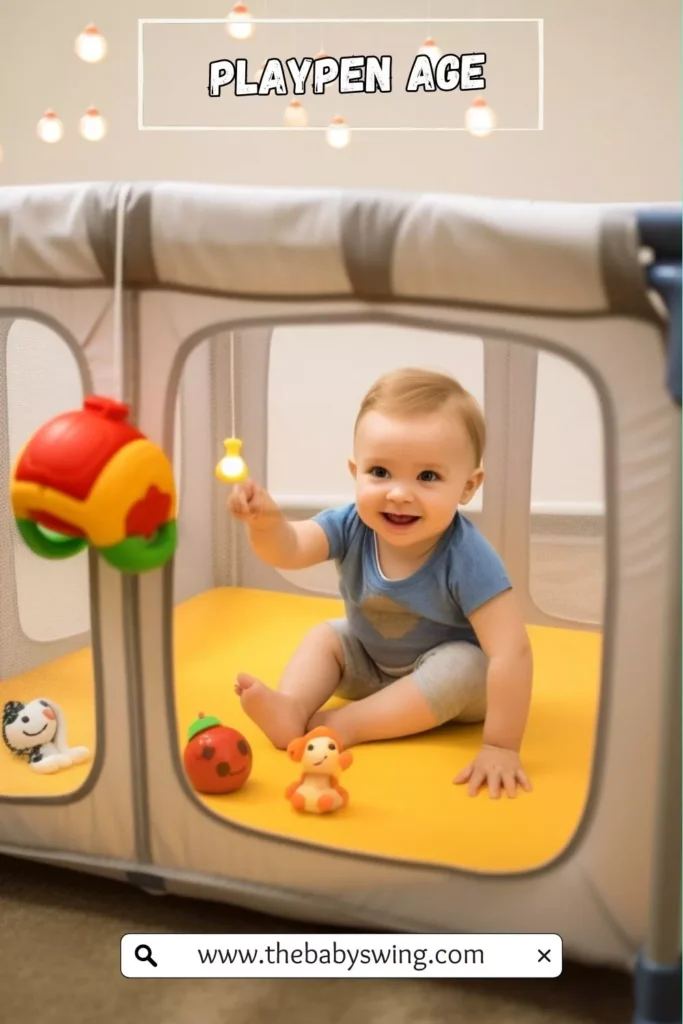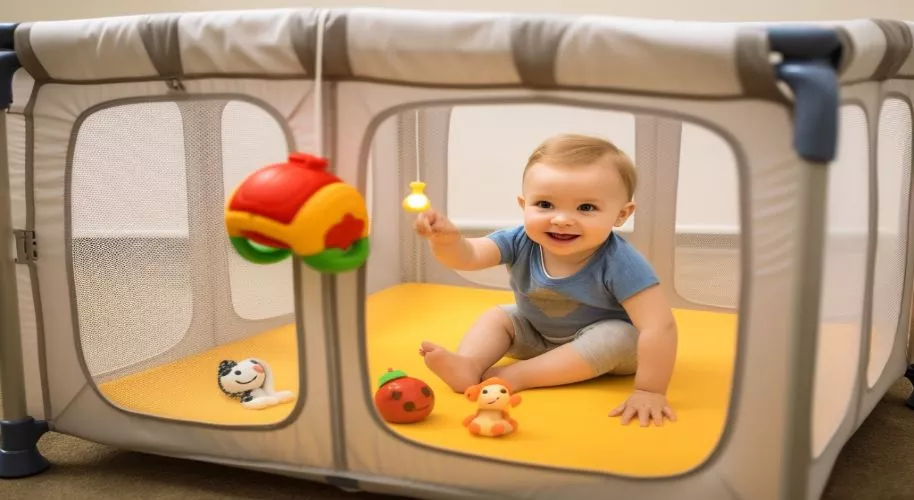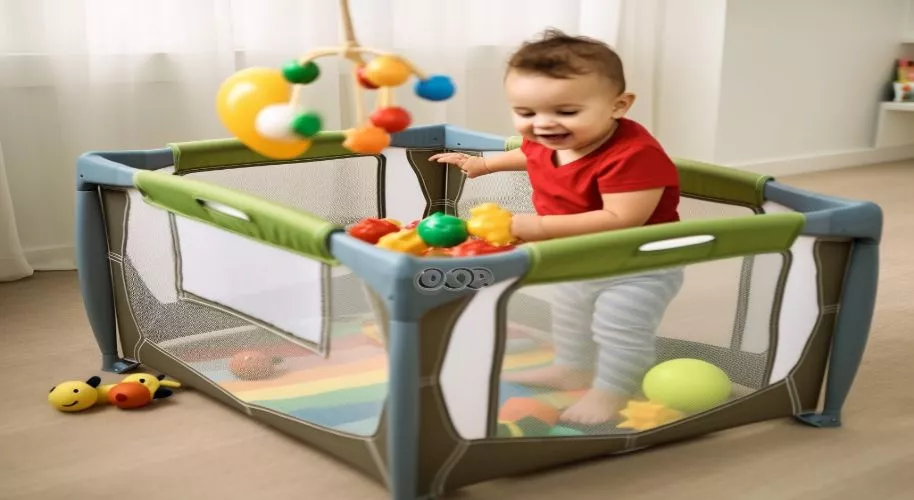Last Updated on October 30, 2023
Playpen age refers to the stage in a child’s development when they are old enough to explore and play in a playpen safely. It is an exciting milestone that marks a transition from being confined to cribs or other limited spaces to having a safe and secure environment to move around in.
Playpens provide a controlled space where children can play independently, interact with toys, and develop their motor skills. They also offer supervision and containment that gives parents peace of mind while allowing their children to explore and learn.
The ideal playpen age may vary for each child but typically falls between 6 months to 2 years. During this time, playpens are valuable for fostering independence and promoting a child’s overall development. Keep reading this article with our experts’ knowledge-based opinions for further knowledge.

What is a Playpen?
A playpen, or a play yard, is a portable, enclosed space for infants and young children to play and explore safely. It typically consists of a sturdy frame made of metal or plastic, with mesh or fabric walls and a padded floor.
Playpens often have a gate or a door for easy access and can be easily folded and transported. They provide a controlled environment where parents can confine their children while they attend to other tasks, ensuring the child’s safety and well-being.
Playpens are equipped with toys, activity panels, and interactive features to stimulate the child’s senses and encourage learning and development.
When Is a Baby Too Old for Playpens?
Determining when a baby is too old for playpens can vary based on the child’s development and needs. Our experts and medical professionals say the optimal age range for using a playpen is between six and eight months old. During this period, infants typically have good head and neck control, making navigating within the playpen safer.
Dr. Benjamin Spock highlights that around 18 to 24 months, or if a child grows rapidly, a playpen may no longer be the best play area for them. The child’s increasing mobility and need for more space to explore may make a playpen feel restrictive.
If a child is almost three years old, they might have outgrown the playpen. They are becoming more independent at this age and may benefit from a larger play area.
What are the Different Types of Playpens for Babies?

Various types of playpens are available for babies, each with unique features and benefits. Here are some common types of playpens:
Traditional Playpens:
These playpens have a classic design with a sturdy frame made of metal or plastic and mesh or fabric walls. They often come with a gate or door for easy access and can be folded for storage or travel.
Portable Playpens:
Designed for easy transportation, portable playpens are lightweight and compact. They typically feature a collapsible design and carry a bag, making them ideal for trips or visits to grandparents’ houses.
Playpens with Activity Panels:
These playpens include interactive activity panels attached to the walls. These panels may feature toys, buttons, musical elements, and sensory activities to engage the baby’s senses and promote cognitive development.
Convertible Playpens:
Also known as playpen cribs, these versatile options can convert into a crib or a bassinet. They offer a dual-purpose solution, allowing the playpen to be used for both playtime and sleep.
Expandable Playpens:
Ideal for growing babies, these playpens have modular designs that allow for expansion by adding additional panels. This feature enables customization of the playpen’s size and shape to suit different spaces and requirements.
Playpens with Canopies:
Some playpens have built-in canopies or sunshades to provide shade and protection from sunlight outdoors. This feature is particularly useful during outdoor activities or picnics.
Pop-up Playpens:
These playpens are designed for quick and easy setup. They feature a pop-up mechanism that allows them to be assembled or folded down in seconds, making them convenient for parents on the go.
In what Various Ways can a Playpen be Used?
A playpen is a versatile and practical baby product that offers various ways to be used. Here are some common uses of a playpen:
- Safe Play Area:
The primary purpose of a playpen is to provide a secure and enclosed space for babies to play and explore. It offers a controlled environment where parents can confine their little ones, ensuring their safety while allowing them to have fun.
- Naptime Spot:
Playpens with padded floors or mattresses can double as a cozy spot for babies to take naps. The enclosed space provides security, helping babies feel comfortable and promoting better sleep.
- Containing Active Toddlers:
As babies grow into active toddlers, they may require boundaries to keep them in one place. A playpen can serve as a containment area, preventing toddlers from wandering off or getting into potentially dangerous situations while parents attend to other tasks.
- Travel Companion:
Portable playpens are designed for easy transportation. They can be folded down and packed into a carrying bag, making them convenient for travel. Whether it’s a road trip, a visit to relatives, or a day at the park, a playpen ensures babies have a familiar and safe space.
- Outdoor Safety:
Playpens with canopies or sunshades are ideal for outdoor use. They protect from the sun’s harmful rays, shielding babies from direct sunlight while allowing them to enjoy fresh air and outdoor play.
- Pet Separation:
Playpens can also create a separate area for babies away from pets. This helps ensure safe interaction between babies and animals, especially during the initial introduction stages.
- Training Ground for Independent Play:
A playpen encourages babies to explore and play independently. It provides a space where they can discover their surroundings, interact with toys, and develop fine motor skills. Independent playtime in a playpen promotes self-confidence and fosters cognitive and sensory development.
What are the Suitable Age Ranges for Playpens?

When it comes to determining the suitable age range for playpens, expert opinions may vary. Some general guidelines can help parents make an informed decision.
According to Dr. Lauren Levine, a pediatrician, babies can use a playpen as early as four months. At this age, babies are becoming more aware of their surroundings and can benefit from a safe and confined space for play. The playpen helps them develop a sense of independence and provides a secure environment for exploration.
Dr. Jennifer Shu, another pediatrician, suggests that the ideal age for introducing a playpen is around six months when babies start crawling. Crawling is a significant milestone, and a playpen can offer a controlled area for babies to practice their newly acquired mobility skills while ensuring their safety.
It’s important to note that playpens should not replace active and supervised playtime with adults. Babies still require interaction, stimulation, and socialization. Playpens should be seen as a tool to complement adult-guided play rather than a substitute.
What can Babies Do Once They’ve Outgrown the Playpen?
Once babies have outgrown the playpen, they are ready to explore and engage with their environment in new ways. Here are some activities that babies can enjoy once they’ve outgrown the playpen:
- Independent Play:
Babies develop more advanced motor skills and cognitive abilities as they age. They can independently engage in independent play, exploring toys, books, and sensory materials. This encourages creativity, problem-solving, and self-expression.
- Tummy Time:
Tummy time is crucial for strengthening muscles and promoting development. Once babies have outgrown the playpen, they can enjoy extended tummy time on a soft mat or carpet. This helps build core strength, improve head control, and prepare them for crawling and walking.
- Crawling and Walking:
Once babies are mobile, they can explore their surroundings by crawling and walking. This newfound freedom allows them to move throughout the house, interact with different objects, and practice balance and coordination.
- Outdoor Exploration:
Taking babies outside to experience nature is beneficial for their development. They can explore textures, sounds, and sights in the outdoors. Whether playing in the grass, walking, or visiting a park, outdoor exploration stimulates their senses and promotes physical activity.
- Social Interaction:
As babies grow, they become more aware of the people around them. They can interact socially with parents, siblings, and other family members. This includes playing simple games, imitating facial expressions, and engaging in verbal communication.
- Sensory Play:
Sensory play activities, such as finger painting, exploring different textures, or playing with sand and water, can provide endless entertainment for babies. These activities stimulate their senses, promote fine motor skills, and encourage cognitive development through hands-on exploration.
- Music and Movement:
Babies often enjoy music and movement activities. Dancing, clapping to the rhythm, and playing with musical instruments can bring joy and help develop coordination and rhythm.
Why is it Not Recommended to Put Your Baby in a Playpen After Two Years?
Putting your baby in a playpen after two years of age is generally not recommended. Experts suggest playpens should be used during the early developmental stages and gradually phased out as the child ages.
According to pediatrician Dr. Lauren Levine, “After the age of two, children need more space to move and explore their environment freely. Restricting them to a playpen may hinder their physical and cognitive development.”
Dr. Jennifer Shu, another pediatrician, adds, “By the age of two, most children have developed sufficient mobility and coordination skills to navigate their surroundings safely without the need for a playpen.”
Prolonged use of a playpen beyond the appropriate age can limit a child’s opportunities for social interaction, exploration, and independent play. Children need the freedom to move, explore, and interact with their environment to support their development.
You Might also Like These Reviews!
How Should You Prepare When Your Baby Outgrows Their Playpen?
When your baby outgrows their playpen, it’s important to make some preparations to ensure their continued safety and development. Here are some points to consider when transitioning away from the playpen:
- Childproofing:
As your baby gains more freedom to explore, ensure your home is adequately childproofed. Secure cabinets, cover electrical outlets and install safety gates on stairs to prevent accidents. Remove any small objects or hazards that may be within reach.
- Create a Safe Space:
Designate a specific area in your home where your child can play freely. This could be a childproofed room or a designated play area with soft mats or rugs. Ensure this space is free from potential dangers and provides ample room for your child to move around and explore.
- Supervision:
Keep a close eye on your child as they explore their environment outside the playpen. While it’s important to encourage their independence, supervision is crucial to ensure their safety and intervene if necessary.
- Age-Appropriate Toys:
Provide a variety of age-appropriate toys and activities to stimulate your child’s development. These include puzzles, building blocks, books, art supplies, and sensory materials. Rotate toys regularly to maintain their interest and offer new learning opportunities.
- Encourage Physical Activity:
To support your child’s physical development, create opportunities for movement and exercise. Consider setting up a safe play area with climbing structures, ride-on toys, and balls. Encourage outdoor play and exploration whenever possible.
- Social Interaction:
Encourage your child to interact socially with siblings, playmates, or other children in structured settings such as playgroups or daycare. This will help develop their social skills, sharing abilities, and cooperation.
- Set Boundaries:
Establish clear boundaries and rules to guide your child’s behavior outside the playpen. Teach them about safe areas, what items they can touch or play with, and what is off-limits. Consistent reinforcement will help them understand and respect these boundaries.
What are the Pros and Cons of a Playpen?
Playpens, also known as playards or playpens, can offer advantages and disadvantages for parents and their babies. Here are some pros and cons to consider when using a playpen:
Pros:
- Safety:
Playpens provide a controlled environment where parents can safely keep their babies and toddlers. It prevents them from accessing potentially hazardous house areas, such as stairs or rooms with sharp objects.
- Contained Play Area:
Playpens offer a designated space for babies to play, allowing parents to engage in other tasks while keeping an eye on their little ones. This can be particularly useful for parents who need a brief hands-free time.
- Travel Convenience:
Portable playpens are lightweight and easy to transport, making them ideal for home or travel. They provide a familiar and secure space for babies to play and sleep while away from home.
- Boundaries and Independence:
Playpens help establish boundaries for young children, teaching them to stay within a confined area. This can promote independence and give parents peace of mind knowing their child is safe.
Cons:
- Limited Mobility:
While playpens offer safety, they can restrict a child’s movement and exploration. Babies may have less opportunity to develop gross motor skills and practice crawling or walking if confined to a playpen for extended periods.
- Lack of Social Interaction:
Spending too much time in a playpen may limit a child’s exposure to social interactions and engagement with siblings or other children. This could impact their social development and ability to interact with others.
- Potential Boredom:
If a child is left alone in a playpen for long periods without engaging in toys or activities, they may become bored or frustrated. Ensuring the playpen is stocked with age-appropriate toys and materials is important to stimulate learning and development.
- Dependency:
Over-reliance on a playpen can hinder a child’s ability to explore their surroundings and develop independence. It is essential to gradually reduce the use of a playpen as a child grows older and gains more mobility.
- Space Requirement:
Playpens take up space in the home and may not be suitable for families with limited living areas. Before purchasing a playpen, consider the available space and whether it will fit comfortably in your home.
Are playpens bad for development?
The debate surrounding playpens and their impact on a baby’s development is ongoing. While some argue that playpens can harm a child’s physical and mental growth by restricting exploration, others believe they offer a safe and controlled environment.
Prolonged confinement in a playpen may limit a child’s natural curiosity and social interaction, potentially hindering their development. However, it is important to note that playpens can still be useful when used appropriately and in moderation.
As with any parenting decision, it’s crucial to consider individual circumstances, balance safety with opportunities for exploration, and provide ample supervised time outside the playpen.
How to determine the playpen weight limit?
To determine the weight limit of a playpen, there are a few key points to consider:
- Check the Manufacturer’s Guidelines:
The first step is to consult the manufacturer’s guidelines or user manual for the specific playpen model. The weight limit is typically mentioned in this documentation.
- Consider Federal Regulations:
Playpens are federally regulated, and most models have weight limits that adhere to these regulations. The weight limit for a pack-and-play is usually between 25 and 30 pounds.
- Look for Height Limitations:
Along with weight limits, playpens may also have height restrictions. These limitations ensure that the child remains safe and comfortable within the playpen.
- Take Safety into Account:
It is crucial to prioritize safety when determining the playpen weight limit. If a child nears or exceeds the weight limit, it may be time to transition them to a more suitable sleeping or play environment.
How Does a Pack and Play Differ from a Playpen?
A pack-and-play, also known as a playard, is a type of playpen that typically offers additional features and functionality compared to a traditional playpen. While both provide a safe space for a child to play, their portability and versatility are the main differences.
A pack-and-play is designed to be easily collapsible and portable, making it convenient for travel or storage. It often includes features such as a removable bassinet, changing table, and built-in storage pockets.
On the other hand, a playpen is typically a fixed structure that is less easily foldable or transportable. It may need more features found in a pack-and-play.
What Factors Should I Consider Before Purchasing a Playpen?
Before purchasing a playpen, it’s important to consider several factors to ensure you make the right choice for your child. Here are some key points to keep in mind:
- Safety:
Look for a playpen that meets safety standards and has features like sturdy construction, non-toxic materials, and secure locking mechanisms.
- Size and Space:
Consider the available space in your home or when traveling. Choose a playpen that fits comfortably in your desired area and provides ample room for your child to move around.
- Portability:
If you plan to use the playpen for travel or frequent relocation, opt for a lightweight and easily foldable model that is convenient to transport and set up.
- Versatility:
Some playpens offer additional features such as adjustable height, removable bassinet or changing table, storage pockets, and wheels for easy mobility. Assess your needs and choose a playpen that suits your requirements.
- Ease of Cleaning:
Look for a playpen with removable and washable fabric or materials that are easy to clean and maintain.
- Customer Reviews:
Read reviews and ratings from other parents to gauge the durability, functionality, and overall satisfaction with the playpen you are considering.
How Can I Ensure a Playpen is Both Safe and Fun?
Ensuring that a playpen is safe and fun for your child is essential. Here are some points to consider:
- Safety Features:
Choose a playpen with safety features such as sturdy construction, smooth edges, secure locking mechanisms, and non-toxic materials. Look for certifications or compliance with safety standards.
- Proper Assembly:
Follow the manufacturer’s instructions carefully while assembling the playpen to ensure it is set up and stable. Double-check all connections and locks regularly.
- Age-Appropriate Toys:
Select appropriate toys and activities for your child’s age and development. Avoid small parts that could be a choking hazard.
- Supervision:
Always supervise your child while they are in the playpen. Regularly check for any hazards or potential risks and intervene when necessary.
- Comfortable Environment:
Ensure the playpen has a comfortable mattress or padding to provide a soft surface for your child to play or rest on.
- Rotate Toys:
Keep the playpen engaging by rotating toys and introducing new ones periodically. This helps maintain your child’s interest and prevents boredom.
- Interactive Play:
Engage with your child in the playpen by singing, talking, or playing games together. This interaction enhances their play experience and creates a positive and stimulating environment.
Wrapping up
Playpens are a great tool to provide a safe space for your little one to explore and learn. When selecting the right playpen, consider factors such as safety, size & space, portability, versatility, ease of cleaning, customer reviews, etc.
Additionally, ensure that the playpen is safe and fun by properly setting up safety features and selecting age-appropriate toys. Supervise your children while they play and interact with them to create a positive and stimulating environment.
With the right precautions, you can ensure your child has a safe and enjoyable playtime in their playpen!
Sharing is Caring!
You Might Also Like These Latest Content !

Dr. Leah Alexander is a board-certified general pediatrician who has been in practice for over 20 years. She began working as a pediatrician at Elizabeth Pediatric Group of New Jersey in 2000. Since 2005, she has been working as an independently contracted pediatrician with Medical Doctors Associates at Pediatricare Associates of New Jersey. Read more

